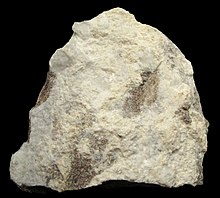| Portlandite | |
|---|---|
 Portlandite and ettringite | |
| General | |
| Category | Oxide mineral |
| Formula (repeating unit) | Ca(OH)2 |
| IMA symbol | Por[1] |
| Strunz classification | 4.FE.05 |
| Dana classification | 06.02.01.04 Brucite group |
| Crystal system | Trigonal |
| Crystal class | Hexagonal scalenohedral (3m) H-M symbol: (3 2/m) |
| Space group | P3m1 |
| Unit cell | a = 3.589 Å, c = 4.911 Å; Z = 1 |
| Identification | |
| Color | Colorless, white to greenish white |
| Crystal habit | Hexagonal plates; commonly fibrous, powdery, massive. |
| Cleavage | Perfect on {0001} |
| Tenacity | Sectile with flexible cleavage plates |
| Mohs scale hardness | 2 |
| Luster | Pearly on cleavages |
| Diaphaneity | Transparent |
| Specific gravity | 2.23 |
| Optical properties | Uniaxial (−) |
| Refractive index | nω = 1.574 nε = 1.547 |
| Birefringence | δ = 0.027 |
| Solubility | Soluble in water producing an alkaline solution |
| Alters to | Alters to CaCO3 on exposure to CO2 bearing waters |
| References | [2][3][4][5][6] |
Portlandite is a hydroxide-bearing mineral typically included in the oxide mineral class. It is the naturally occurring form of calcium hydroxide (Ca(OH)2) and the calcium analogue of brucite (Mg(OH)2).
- ^ Warr, L.N. (2021). "IMA–CNMNC approved mineral symbols". Mineralogical Magazine. 85 (3): 291–320. Bibcode:2021MinM...85..291W. doi:10.1180/mgm.2021.43. S2CID 235729616.
- ^ "Mineralienatlas - Fossilienatlas". www.mineralienatlas.de.
- ^ "Handbook of Mineralogy" (PDF).
- ^ "Portlandite: Mineral information, data and localities". www.mindat.org.
- ^ "Portlandite Mineral Data". www.webmineral.com.
- ^ Pallache, Charles; Berman, Harry; Frondel, Clifford (1944). The System of Mineralogy of James Dwight Dana and Edward Salisbury Dana (7 ed.). Wiley. pp. 641–642. ISBN 9780471192398.